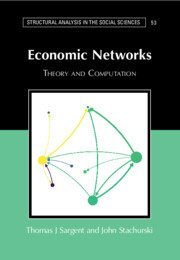Description
Economic Networks
Theory and Computation
Structural Analysis in the Social Sciences Series
Authors: Sargent Thomas J., Stachurski John
Language: English
Subject for Economic Networks:
40.64 €
In Print (Delivery period: 14 days).
Add to cart
Publication date: 04-2024
266 p. · Paperback
266 p. · Paperback
Description
/li>Contents
/li>Biography
/li>
It has become increasingly clear that economies can fruitfully be viewed as networks, consisting of millions of nodes (households, firms, banks, etc.) connected by business, social, and legal relationships. These relationships shape many outcomes that economists often measure. Over the past few years, research on production networks has flourished, as economists try to understand supply-side dynamics, default cascades, aggregate fluctuations, and many other phenomena. Economic Networks provides a brisk introduction to network analysis that is self-contained, rigorous, and illustrated with many figures, diagrams and listings with computer code. Network methods are put to work analyzing production networks, financial networks, and other related topics (including optimal transport, another highly active research field). Visualizations using recent data bring key ideas to life.
Preface; Common symbols; 1. Introduction; 2. Production; 3. Optimal flows; 4. Markov chains and networks; 5. Nonlinear interactions; Appendices; 6. Appendix.
Thomas J. Sargent is a Nobel Prize–winning economist and Professor of Economics at New York University. He has held positions at Stanford, Minnesota, Chicago, and Princeton, and served as President of the Econometric Society and of the American Economic Association. He is renowned for his influential research on macroeconomics, rational expectations, and policy analysis.
John Stachurski is a professor at the Australian National University who has made influential contributions to the study of Markov models and dynamic optimization. He is an economist specializing in mathematical and computational economics and is also a co-founder of QuantEcon, a popular platform for open-source economic modeling.
John Stachurski is a professor at the Australian National University who has made influential contributions to the study of Markov models and dynamic optimization. He is an economist specializing in mathematical and computational economics and is also a co-founder of QuantEcon, a popular platform for open-source economic modeling.
© 2024 LAVOISIER S.A.S.




